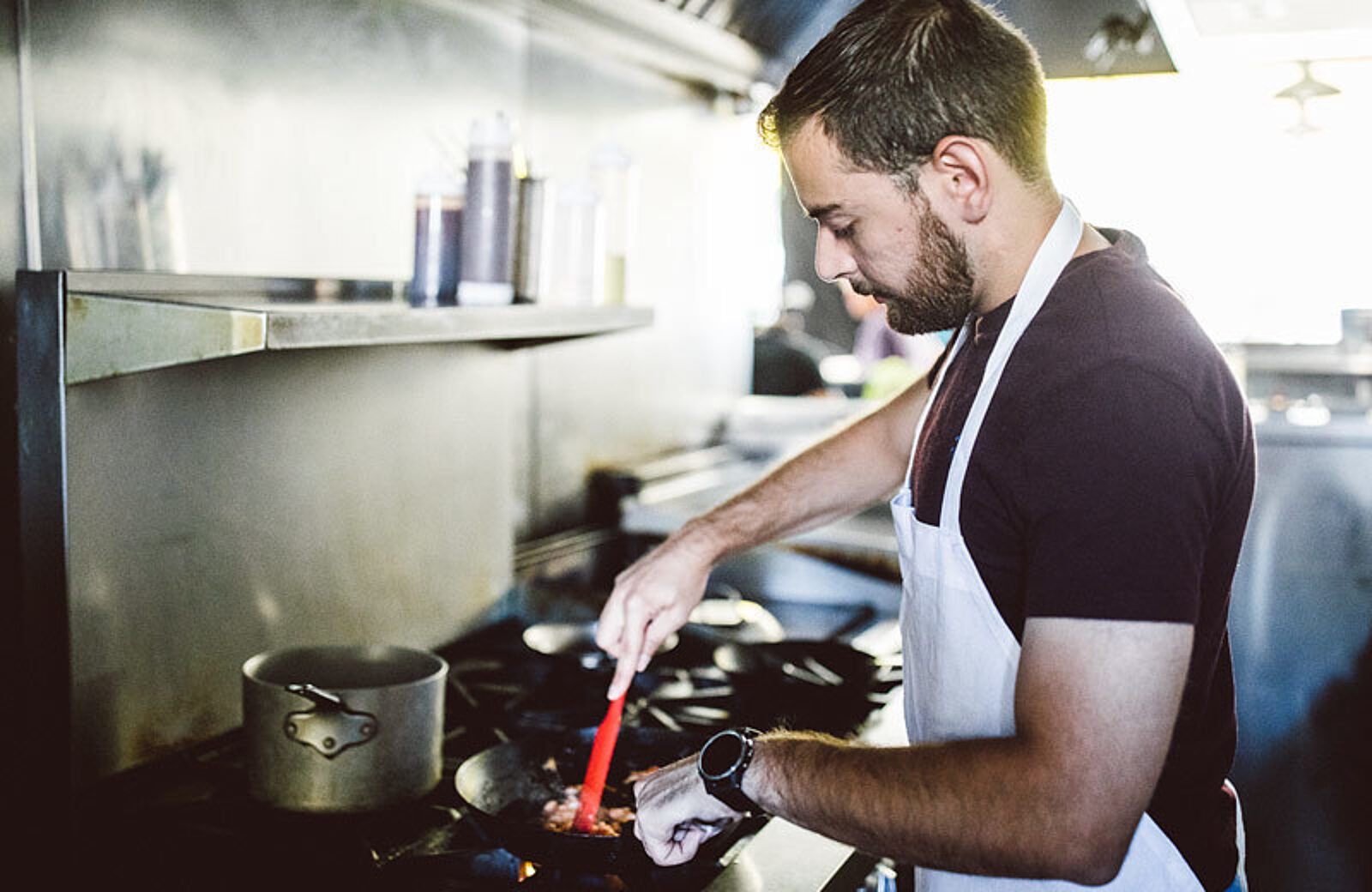
How to Hire a Line Cook: Line Cook Jobs Guide
Learn about the different types of line cooks, and how to hire a line cook for your restaurant — including a job description template for you to use.

Dahlia SnaidermanAuthor
How to Hire a Line Cook: Line Cook Jobs Guide
Your line cooks keep your restaurant running — no food means no customers! But as the food service industry continues to face staffing challenges, it can be very difficult to find a great cook. This hiring guide will help you find and recruit the line cooks who will be churning out amazing food, shift after shift.
Types of Line Cooks to Hire
There are several types of line cooks you can bring onto your restaurant team, and the distinctions are important when you’re hiring and setting pay rates and responsibilities. All line cooks work in the kitchen, and they’re all responsible for cooking various components of your menu.
Depending on the size of your kitchen and menu, you might find yourself needing a mix of a few types of line cooks.
Some kitchens, especially in fine dining, subscribe to the French kitchen brigade system, while others emphasize cross-training and invest in training every cook to know how to do any of these roles.
Some kitchens divide the roles according to cooking methods and kitchen stations.
This list will cover all types of line cooks, many of which can also be known as chef de partie or station chefs. It won’t include more senior roles, like head chef, executive chef, or sous chef — those are covered in our article on types of chefs.
Traditional line cook
Line cooks make up the bulk of cooks in the restaurant industry. They're found in corporate restaurants, hotels, and smaller independent restaurants. They’re usually hired by experience and pay, with an assigned title of Cook #1, Cook #2, Cook #3, etc. Cook #1 would be your most experienced and skilled, and line cooks, in general, have more experience and responsibilities than other cooks on this list. While they’ll sometimes work a specific station, they often do just about anything and everything needed, from apps to entrees to dessert.
Short-order cook
Short-order cooks crank out food at an incredibly fast rate. Short-order cooks assemble and cook items and ingredients that are simple, ready-to-make, and don’t require a lot of prep or technique. You’ll hire them for a burger restaurant, simple breakfast spots, diners, or the more straightforward stations in your kitchen.
Garde Manger or appetizer cook
The garde manger, sometimes known as an appetizer cook, vegetable cook, or simply the cook on the cold station, is typically responsible for preparing salads, simple sides, and vegetables. In some kitchens, garde managers and appetizer cooks have different roles, with the latter also focusing on hot appetizers like soup.
Fish cook
The fish cook handles all seafood, and can be known as a poissonier. Fish cooks will sometimes be responsible for ordering and organizing daily inventory and specials with your seafood vendor.
Fry cook
The fry cook manages the fryers and occasionally the grill station – particularly at fast food restaurants.
Grill cook
Grill Cooks are responsible for grilling – mainly meat, but it's not uncommon for veggies to fall onto their station as well.
Saucier or sauté cook
Sauciers are in charge of preparing all the sauces that make your food irresistibly flavorful. In some kitchens, they’re also in charge of preparing meats and sauteeing all the dishes that need a little toss in the pan to come together, like pastas and stir-fries — which is why this role can also be called a saute cook.
Pastry chef
Pastry chefs, or pastry cooks, are responsible for everything dessert. They’re typically only found in restaurants with a strong dessert program including homemade cakes, pastries, and other sweet treats.
What Makes a Great Line Cook?
A great line cook is responsible, passionate, and reliable. They can handle pressure and, in fact, thrive on it. The busier, hotter, and more demanding service gets, the more they step up their game.
At a basic level, you need a line cook you can count on to show up. If a cook shows up late or misses prep, someone else will need to cover their mise en place (and worse, their orders), delaying the entire kitchen’s flow. Reliability is one of the toughest challenges with kitchen staff, and it’s often related to pay, benefits, and working conditions. Read more on that in our retention section.
Line cooks need to be organized and master multitaskers. When the tickets start coming in, they need to be able to focus on the various menu items to be made.
Two more non-negotiables are that line cooks must have excellent time management and communication skills. Restaurant kitchen teams move fast, and if teammates are out of sync (and failing to communicate), things can get chaotic immediately.
And more than anything, it’s a win if you can find a line cook who cares deeply about the experience they’re creating for people through food. This type of drive will motivate anyone to get through a demanding shift.
There are no educational requirements for a line cook — a high school diploma or culinary school aren’t often a must-have for most professional kitchen roles — but line cook roles aren’t generally entry-level positions. Line cooks typically have six months to 2 years of experience under their belt. For aspiring line cooks with no food preparation experience, six months to a year of prep cook work can help get them up to speed on the basics and set them up for success as a line cook.
If you’re short on staff and need to fill a seat ASAP, you’ll need a line cook with excellent knife skills or experience working multiple fryers or stations. But if you’ve got the ability to provide skills training, you can focus on hiring for long-term fit over existing skills. If you invest in building a thorough training program, you might be okay hiring a line cook with minimal experience in particular cooking techniques but who is clearly raring to go and a great behavioral fit for your team.
Hiring a Great Line Cook
Here’s how to hire a line cook.
1. Write out your line cook job description, including line cook duties and responsibilities
Food prep: Depending on the number and types of line cooks you have on the team, a new line cook will be responsible for prepping ingredients relevant to their station. Advertise for skill sets within your area of need (e.g. preparing fresh fish or cuts of meat, uniform chopping skills).
Food safety and hygiene: Line cooks need to maintain organized and clean food stations to ensure food safety standards. Advertise for any food safety certifications you require your employees to have.
Cooking with precision and speed: Explain the type of cooking the line cook will be responsible for. This could include the types of recipes they might need to follow, specific station requirements, or even a description of the type of lunch or dinner rush you experience and what that means for the pace of the work.
Communication and teamwork: Kitchens are tight, hot, and often dangerous spaces to work in. Line cooks need the ability to communicate and coordinate with their team, the chef, and the front-of-house staff. This includes showing up on time and working pre-shift, during-shift, and post-shift in an effective way that builds camaraderie with their team.
Call out the most important line cook skills and traits, like
Keeping a professional attitude under pressure
Working in a fast-paced environment while keeping to deadlines and with precision
Being consistent in preparation, cooking, and presentation skills
Displaying high emotional intelligence and soft skills like as listening, empathy, and self-awareness
2. Determine the line cook wages and benefits you can offer
According to the Bureau of Labor Statistics, the average hourly wage for a restaurant cook in 2022 was $16.32. Of course, this varies by restaurant type and state to state, and of this group, cooks in California made the highest hourly income.
While taxing work environments and long hours contribute to the high turnover in back-of-house jobs, low wages are the biggest frustration for staff. If you can find a way to pay your kitchen staff a competitive wage, you’ll be in a better position to hire skilled candidates — and keep them long-term. Some restaurateurs are experimenting with new restaurant compensation models, like tip sharing and kitchen appreciation fees, to figure out how to make this work.
As much as benefits are expensive, constant hiring is also expensive and time-consuming. Consider providing benefits, including health insurance, to your teams — and watch as your business suddenly becomes a more attractive place to work.
Job Description Template
Write great restaurant job descriptions with this job description template, a customizable Word doc that outlines responsibilities, requirements, and more.

3. Craft your line cook job posting — and post it!
Using all of the above information, put together a line cook job ad. You can use our template, or start from scratch.
Share the job posting on social media, on posters within your place, and pass it along to your community and ask them to share it with their communities. You should also post the ad on industry job boards, and on general online job boards. Some job boards to consider include:
You might also be able to find full-time staff by hiring temporary employees through gig economy sites like Instawork.
Job sites are a great place to start, but you can also try implementing an employee referral program — it can also work wonders.
4. Review applications and line cook resumes
A great line cook will have experience at restaurants similar to your own, and should have the proven ability to work cleanly and efficiently in a high-volume kitchen. But it’s tough to find great, experienced kitchen staff, so you might need to be flexible on some skills and train up on others.
Apart from the necessary skills and experience that align with the job description, you should look for a few things in a line cook resume:
Experience in relevant roles within the speciality you’re searching for
Experience at restaurants you know hold their cooks to a high standard
Extended tenure in previous restaurants
Specialization in the line cook role or more broad experience across a range of restaurant roles
5. Be flexible when scheduling calls and interviews
Line cooks have a lot of job choices right now. You’re busy, but be prepared to give your candidate several interview time slots, and even consider doing open-call hiring hours to attract people who might be interested in learning about your business but don’t want to commit to a full interview.
6. Conduct a line cook interview
Here are some questions to ask in a line cook job interview:
What skills do you bring to the table that you believe will help us run an effective, efficient kitchen?
What’s your favorite dish to cook and why?
How do you ensure the quality of your work?
What made you apply with us and not another restaurant?
What’s one thing that makes you want to stay working with a restaurant?
Interview Questions Template
With culture questions, experience questions, and situational questions, this customizable Word doc will guide your interviews with prospective candidates.

7. Offer a stage shift, but make it paid
A stage shift is a chance for you to get to know a candidate’s skills, experience, and behavior. It’s also a chance for the candidate to see your kitchen team in action, so make sure they’re on their game.
Stage shifts should happen between an interview and a job offer, and you should keep them to less than a few hours. Instead of having a candidate work a station while they’re staging, have them shadow one of your cooks and perform light prep duties at stations that are relevant to the role. Always pay cooks for stage shifts.
When hiring a line cook for your back-of-house staff, hire a candidate who would be a better long-term investment rather than a short-term skill set. If they’re not very experienced but they excel in the stage shift and get along with everyone, they’re a keeper.
8. Extend an offer, choose a start date, and get training!
If you’ve decided to move forward with a candidate, extend an offer verbally, follow up with paperwork, and get them on board. Then, their job training can begin and soon you’ll have another crucial member of the team to get on the schedule.
Related Restaurant Operations Resources
Is this article helpful?
DISCLAIMER: This information is provided for general informational purposes only, and publication does not constitute an endorsement. Toast does not warrant the accuracy or completeness of any information, text, graphics, links, or other items contained within this content. Toast does not guarantee you will achieve any specific results if you follow any advice herein. It may be advisable for you to consult with a professional such as a lawyer, accountant, or business advisor for advice specific to your situation.
Read More
Subscribe to On the Line
Sign up to get industry intel, advice, tools, and honest takes from real people tackling their restaurants’ greatest challenges.





